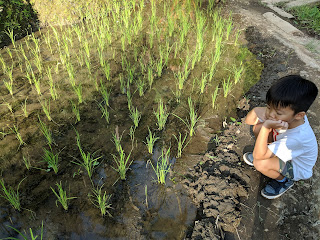After lunch we proceed to Tegalalang Rice Terrace. The driver had explained to us that Tegalalang rice terraces is a UNESCO World Heritage Site located in Ubud, Bali.
Instead of entrance fee, I think there was a booth asking for donations to help maintain this site.
Before we reached the rice terrace, there were a lot of shops and cafe on the stretch of the road (the driver dropped us at the parking area so we will know where he will be waiting for us and we walk down the road to look for the entrance of the rice terrace).
I noticed there were a lot of those street vendors who will ask you to purchase either souvenirs like necklace or postcard which I can't convince myself to purchase as I know that I will throw it away without using at all. I will suggest that just tell them you already purchased from someone else and walk away unless you really want to buy the souvenirs they recommended (to be frank with you, if you get the chance to shop at their local department store... you will find that the same products the street vendor tried to sell to you have already marked up around 4 to 5 times).
We eat rice everyday, but we have never seen a rice paddy. I think this is a good time to educate the children about where does rice comes from. Oh well~ I be frank with you... I don't think the kids are having as much good times as the parents! :p
Address: Jalan Tegallalang, Tegallalang, Kabupaten Gianyar, Bali 80561 Indonesia
Instead of entrance fee, I think there was a booth asking for donations to help maintain this site.
Before we reached the rice terrace, there were a lot of shops and cafe on the stretch of the road (the driver dropped us at the parking area so we will know where he will be waiting for us and we walk down the road to look for the entrance of the rice terrace).
I noticed there were a lot of those street vendors who will ask you to purchase either souvenirs like necklace or postcard which I can't convince myself to purchase as I know that I will throw it away without using at all. I will suggest that just tell them you already purchased from someone else and walk away unless you really want to buy the souvenirs they recommended (to be frank with you, if you get the chance to shop at their local department store... you will find that the same products the street vendor tried to sell to you have already marked up around 4 to 5 times).
We eat rice everyday, but we have never seen a rice paddy. I think this is a good time to educate the children about where does rice comes from. Oh well~ I be frank with you... I don't think the kids are having as much good times as the parents! :p
Address: Jalan Tegallalang, Tegallalang, Kabupaten Gianyar, Bali 80561 Indonesia
We have to walk down from another end to reach the start line
The "houses" shown at the background are the shop houses on the stretch of the street which we came from. The area we stand will lead to the starting line and I guess the other end (which is near the shophouses shown in this picture) will be the ending line
Here we go!
The cultural landscape of Bali consists of five rice terraces and their water temples that cover 19,500 ha. The temples are the focus of a cooperative water management system of canals and weirs, known as subak, that dates back to the 9th century. Included in the landscape is the 18th-century Royal Water Temple of Pura Taman Ayun, the largest and most impressive architectural edifice of its type on the island. The subak reflects the philosophical concept of Tri Hita Karana, which brings together the realms of the spirit, the human world and nature. This philosophy was born of the cultural exchange between Bali and India over the past 2,000 years and has shaped the landscape of Bali. The subak system of democratic and egalitarian farming practices has enabled the Balinese to become the most prolific rice growers in the archipelago despite the challenge of supporting a dense population. (Source: http://whc.unesco.org/en/list/1194 as at 25 Mar 2018 14:57hours)
Poor daddy~ or shall I say strong daddy? The son was too tired to walk hence daddy has been carrying him whenever we need to walk
The Subak system (a cooperative water management system of canals and weirs)
Daddy's explanation video on the rice terrace
Fun swing! By right should be IDR100,000 for 10 swings. However, I'm not sure whether the staff thought we were Chinese from China as I was speaking mandarin with my husband. One lady there told me IDR150,000 in mandarin/Chinese but when they spoke English to other tourist they told them IDR100,000. Even I would like to try I was turned off. I think they didn't know I can speak both Mandarin and English well.
The swing was tie around 2 coconut tree with ropes and they will use harness when you sit on the swing. A very profitable swing I shall say as 10 swings took only around 5 minutes to complete?
View from cafe
























No comments :
Post a Comment